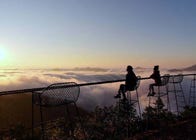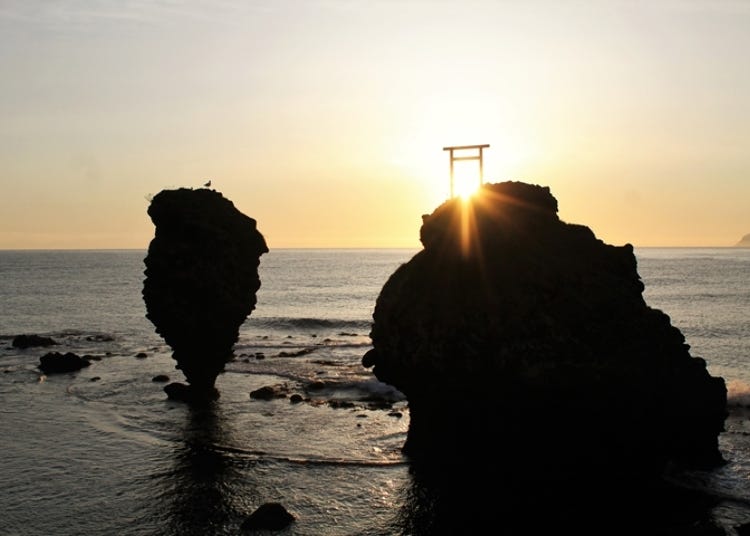
5 Picturesque Floating Torii Gates in the Seas of Hokkaido
- Written by: Nobuka Kawashima
Hokkaido is located in the northernmost part of Japan, and is home to some little-known magical photo spots. Namely, the torii gates that stand in the beautiful sea.
You may be familiar with some famous floating torii, such as Itsukushima Shrine in Hiroshima Prefecture, and Shirahige Shrine in Shiga Prefecture. But did you know there were some in Hokkaido, as well?
The floating torii gates in the towns of Shosanbetsu and Esashi have garnered quite a bit of attention on social media over the last few years. The towns of Okushiri, Rishiri, and Yoichi are also home to some rather unusual floating torii that have been secretly growing in popularity, as well.
But now, the secret is out as we introduce some little-known Hokkaido spots known for their magnificent views.
Above photo courtesy of Yoichi Tourism Association
What is a Torii? The meaning and purpose of torii gates
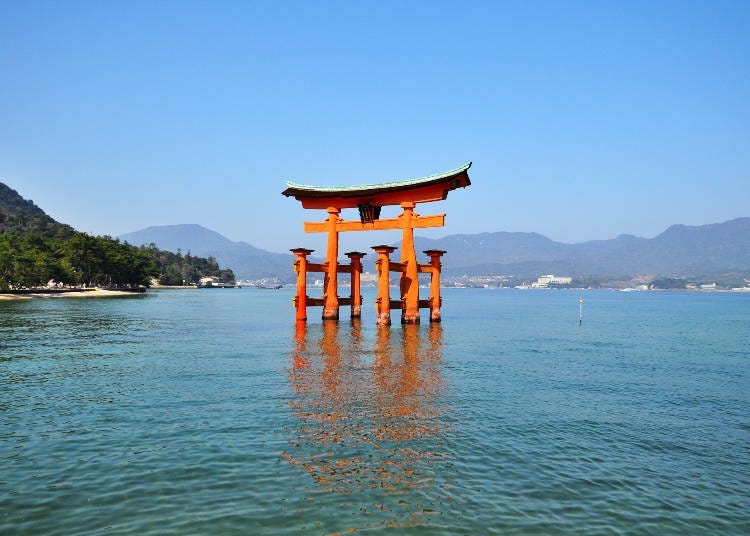
Torii were originally built as entrance gates to shrines and other sacred places. What lies before the torii are the towns where people live, while the land past the gates is considered the sacred grounds of the gods.
In other words, torii act as the border between the human and spiritual world and symbolize that beyond those gates is where the gods reside.
You'll almost always find torii at shrine entrances without fail. However, they may also be found in other sacred places throughout the seas and mountains.
Floating torii gates were often built in the seas as a prayer for abundant fishing catches and safe voyages.
1. Stunning sunset photo spot! The torii at Konpira Shrine (Shosanbetsu, Hokkaido)
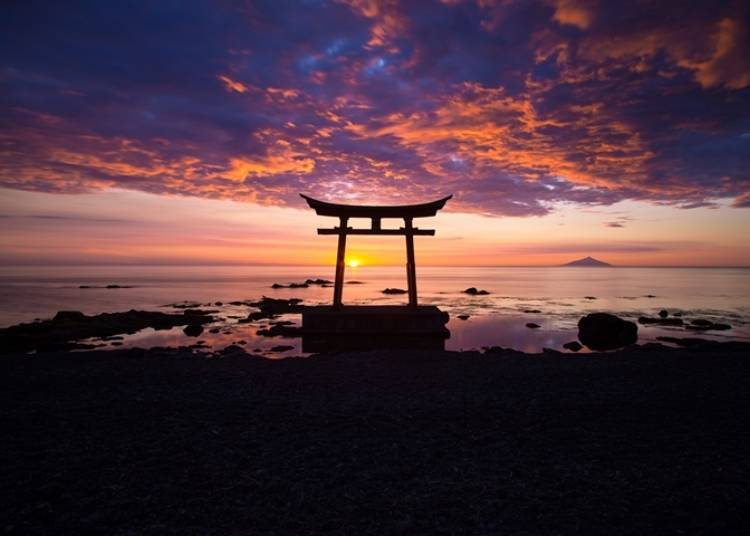
The torii gate at Cape Konpira in northern Hokkaido's Shosanbetsu Village has gained quite a lot of attention on Japanese social media in recent years. Boasting a nighttime view that is simply superb, it is a highly recommended place for anyone interested in photography.
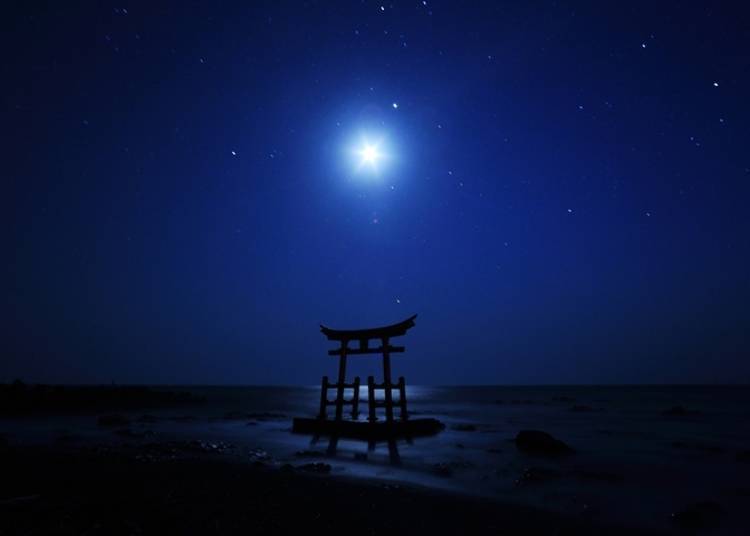
When visiting Shosanbetsu, the most convenient option is to rent a car. It's located about two hours from Wakkanai Airport, the northernmost airport in Japan, and about three hours from Hokkaido's Asahikawa Airport.
An easy landmark is Misakidai Park (Roadside Station Roman Kaido Shosanbetsu), a park that extends over the hills of Kompira.
Misakidai Park has restaurants, hot springs, campgrounds, and an observatory where you can admire the town's signature starry sky.
While there are no trains in the area, there is a highway bus that departs from Hokkaido's largest city, Sapporo. The ride is about four hours long, plus a 20-minute walk once you get off the bus.
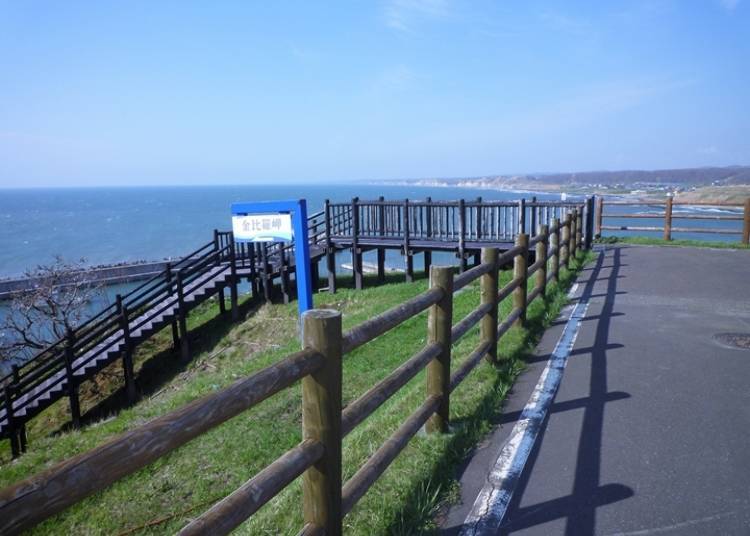
At Cape Konpira, you'll find the torii on the beach and Kompira Shrine on the rocks. The shrine is unmanned and only consists of another short torii gate on the rocks and the small wayside shrine.
In fact, it's so small that if you're visiting in a group, you'll have to proceed one by one to enter the shrine!
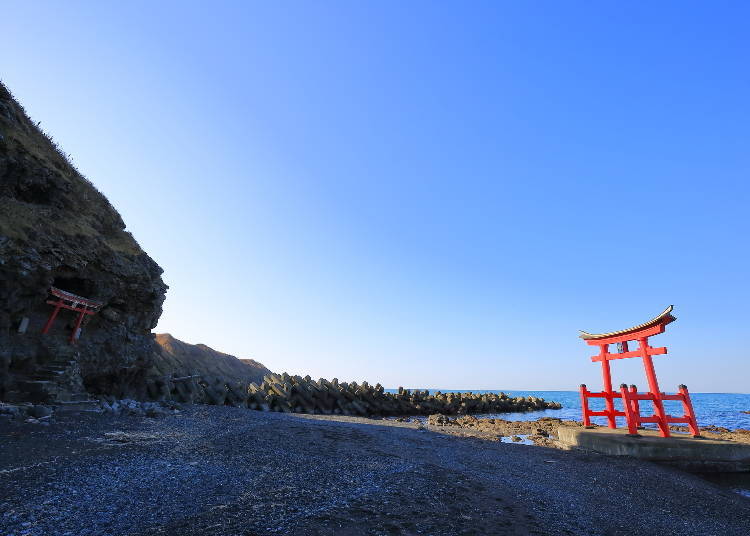
This Konpira Shrine, built in 1907, is said to have originated from a local fisherman who enshrined a plaque that had drifted ashore from the Kotohiragu Shrine in western Japan's Kagawa Prefecture.
Legend has it that accidents on the nearby seas have decreased since then. Every year on July 20, the shrine holds a unique festival where you can observe some Shinto rituals.
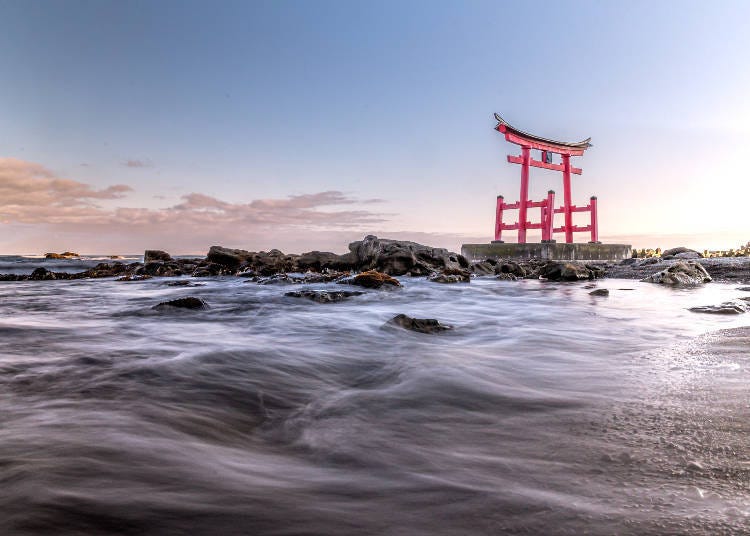
The floating torii, on the other hand, was built relatively recently in 1981. A local fisherman was said to have built it in front of Konpira Shrine to pray for bountiful fishing catches and protection from accidents on the seas.
While this torii is the private property of the relatives of the same fisherman, visitors are allowed to see the shrine and take pictures.
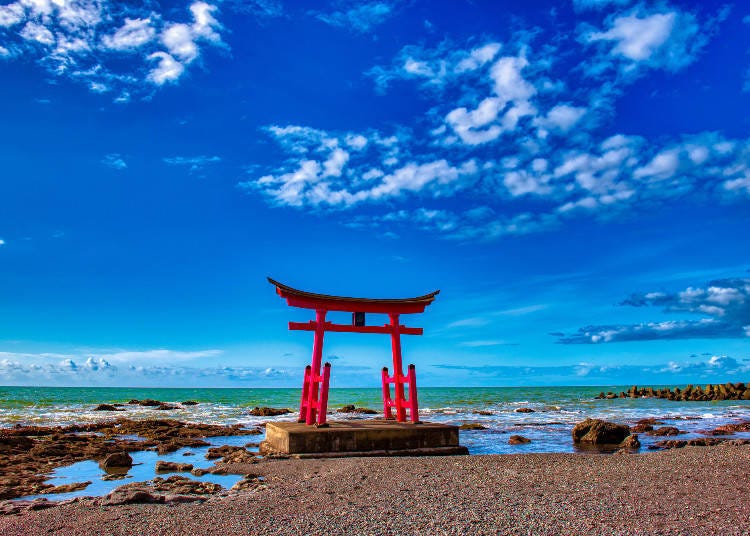
Mornings are best for torii photos with clear blue skies and the shining sun. Before sunset, you can capture a fantastic evening view with the torii's silhouette.
It's a spectacular photo spot that you won't want to pass by! However, avoid visiting during the snowy winter and on days with high tides. We recommend stopping by while driving through northern Japan!
-
Cape Konpira金比羅岬
- Address Toyosaki, Shosanbetsu, Hokkaido 078-4431
2. Itsukushima Shrine and Kamomejima Floating Torii (Esashi Town, Hokkaido)
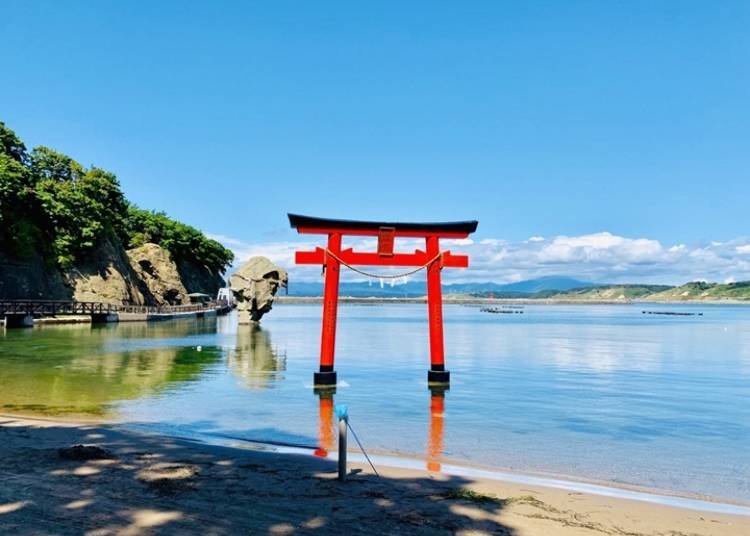
Another floating torii gate is located in Kamomejima Island in southern Hokkaido's Esashi Town, connecting to mainland Hokkaido via sandy beaches and breakwaters. It only takes a few minutes on foot to get there.
The island's circumference is about 2.6km, with the highest point 30m above sea level. A footpath also takes you around the island in about an hour.
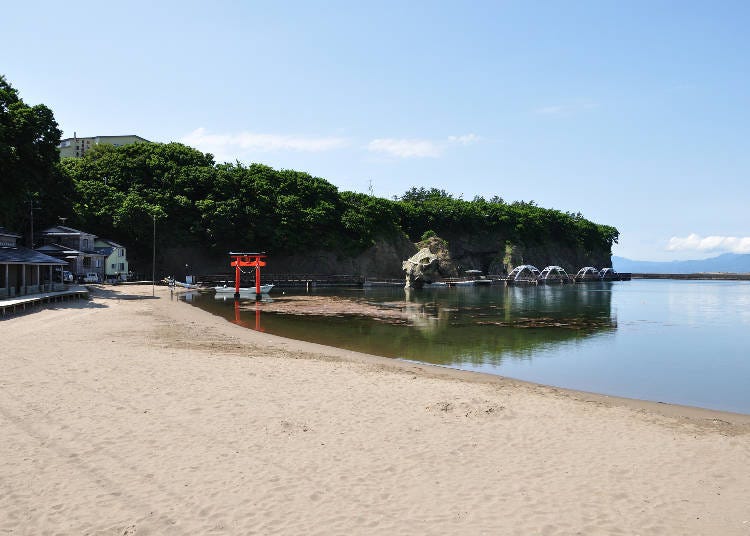
You can reach Esashi Town from Hakodate City, famous for its nighttime view, in about 1 hr 30 min by car, and 2 hr 15 min by bus. If taking the Hokkaido Shinkansen, you can catch a bus from Shin-Hakodate Hokuto Station (about 1 hr 15 min) or from Kikonai Station (1 hr 30 min). Ride either bus to Ubagamicho Ferry, and from there, walk about ten minutes to Kamomejima Island.
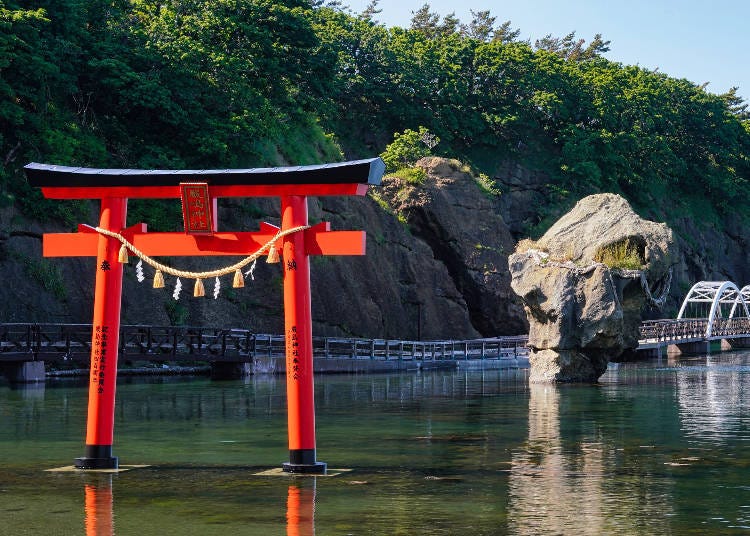
The torii is located on the east side of the island. As it becomes easily overshadowed in the evening, we recommend going from morning to noon for bright, sunny photos.
It is always surrounded by water, even during low tide, so you cannot walk underneath or get closer for photos.
However, you can get some high-quality snapshots of the torii from the footpath, together with Heishi-iwa, the huge, oddly-shaped rock on the beach beside it.
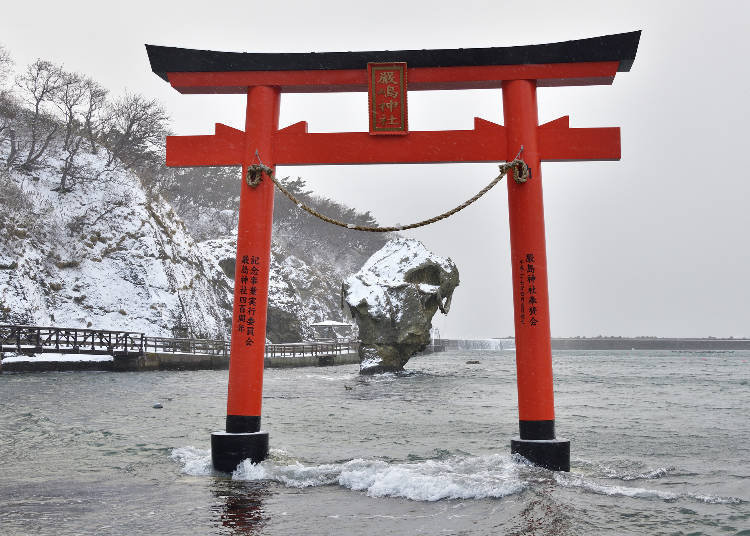
The legend of Heishi Rock tells of a deity who brought about an abundant supply of fish to the island about 500 years ago. As a tribute to that deity, it is decorated with a shimenawa (a thick rope indicating a sacred place visited by the gods).
The floating torii gate was only recently built in 2015 by local fishermen to commemorate the 400th anniversary of the island's Itsukushima Shrine.
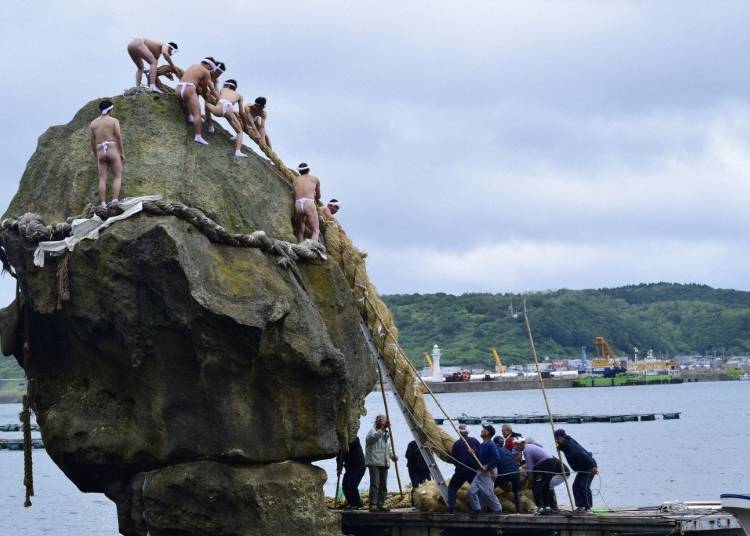
Kamomejima's Itsukushima Shrine is a branch of the shrine of the same name in Hiroshima Prefecture. It was built in 1615 by local sailors as a prayer for safe marine transportation. The shrine was renamed Itsukushima Shrine in 1868.
The floating torii is located in a position that overlooks Heishi Rock and Itsukushima Shrine from between the torii gates. However, as Itsukushima Shrine is located in the inner part of the island, you can't directly see the shrine itself from the torii.

Esashi Town is dotted with historical spots like Kamomejima's Itsukushima Shrine and Ubagamidai Jingu Shrine, said to have been built in 1447.
About an hour south by car is Matsumae Castle, the northernmost Japanese-style castle in the country. These attractions are also recommended for anyone who wants to experience Japanese culture in Hokkaido!
-
Kamomejima Islandかもめ島
- Address Kamomejima, Esashi, Hokkaido 043-0045
3. Stunning view atop a 164-step staircase: Miyatsu Bentengu Shrine (Okushiri Town, Hokkaido)

Prepare to be impressed by this stunning shrine! Miyatsu Bentengu is located in Okushiri Town. It sits on Okushiri Island, a remote island in the southwestern part of Hokkaido, on a rocky mountain protruding from the sea.
For a great panoramic shot, you'll want to aim from the parking lot area. You can get to Okushiri Island from Esashi Town by boat (about 2 hr 10 min). It's also about 30 minutes by plane from Hakodate City.
Rental cars are available at both the boat port and airport. By car, Miyatsu Bentengu is about 10 min from the port and 35 min from the airport. Although they run on a minimal schedule, there are also fixed-route buses from both ports.
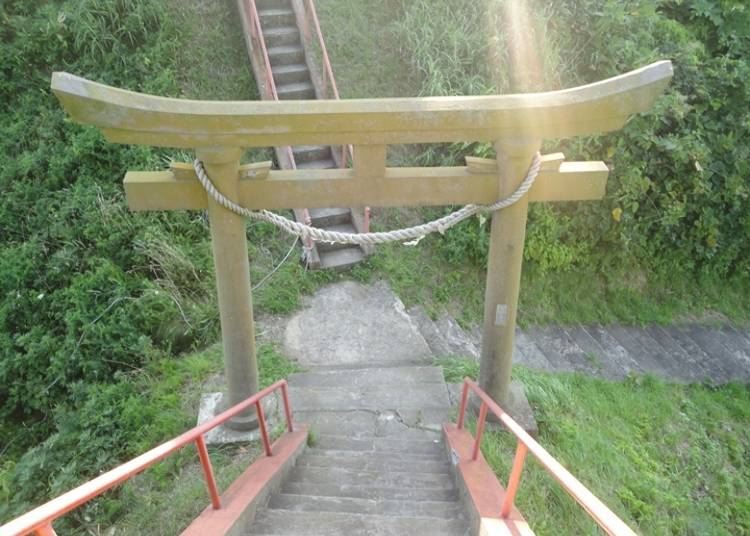
To get to Miyatsu Bentengu, you must first descend the steep staircase along the slope. It's about a 50m height difference from the roadside parking lot! Pass through the torii gate at the bottom, then proceed up the next staircase toward the sky.
Combined, the up and down staircases have 164 steps, for a total of 328 steps for a round-trip visit! While indeed physically demanding, if your body is up to the challenge, this is one shrine you won't want to miss!
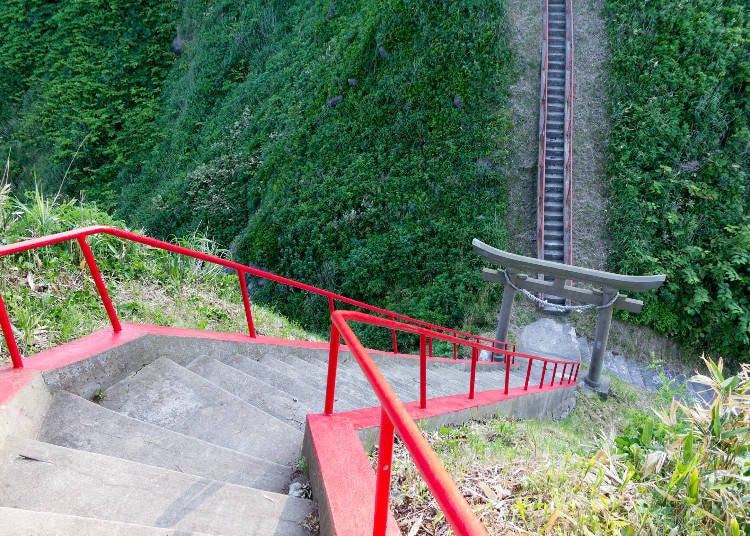
The rocky mountain jutting out of the sea overlooks the strait between the mainland of Hokkaido. It once acted as a base to watch ships entering and leaving the island.
The shrine was built in 1831 by Okushiri locals as a prayer to Benzaiten, god of good fortune, for a bountiful fishing haul. The current shrine was rebuilt once in 1970 and again in 1999. The steep staircase was installed around 1970.
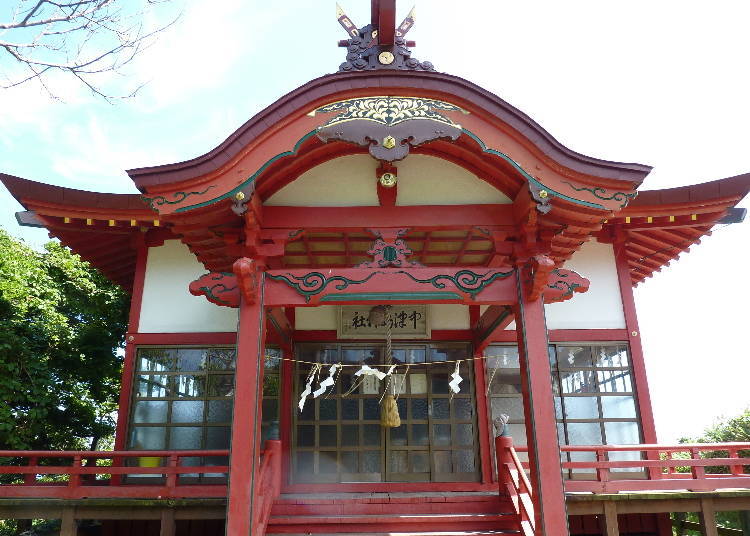
Tourist season on Okushiri Island is generally between May and September, peaking in July and August. You can enjoy water sports such as sea kayaking and waterskiing, and local delicacies such as sea urchin and abalone.
The rock formations along the island's coast also make up a number of photo spots you'll want to try, along with Miyatsu Bentengu. Once you start touring the island, you won't want to put your camera down!
-
Miyatsu Bentengu Shrine宮津弁天宮
- Address Miyatsu, Okushiri, Hokkaido 043-1404
4. Thrilling trek across a bridge: Kitano Itsukushima Bentengu Shrine (Rishiri Town)
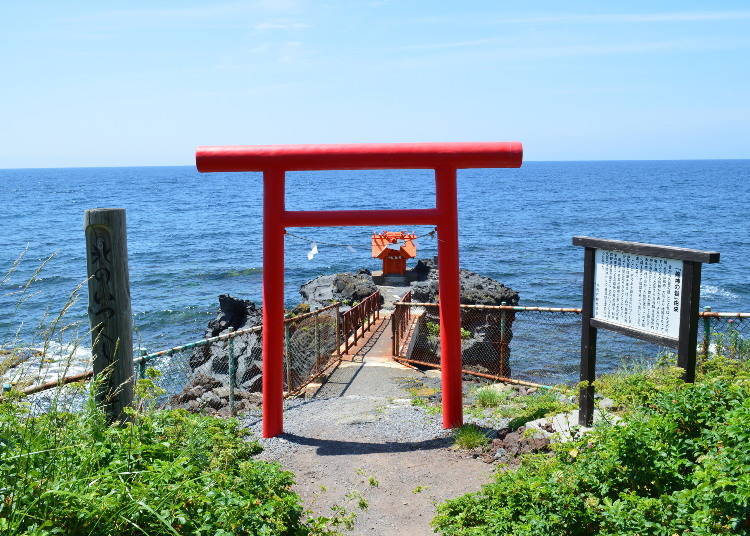
Itsukushima Bentengu Shrine is located in the southwestern part of Rishiri Town on Rishiri Island, a remote island of northern Hokkaido.
The shrine sits atop Ryujin-no-iwa, a rocky mountain protruding from the sea, and also boasts a beautiful view. It also lies along the road that circles the island, granting another great view from the rest area where the lane widens. You can visit the shrine directly by crossing the narrow bridge.
Since the shrine is in the southwestern part of the island, daytime photos tend to have a bright backlight; however, you can capture some stunning shots at dusk. Clear weather provides the perfect opportunity for gorgeous sunset photos over the sea.
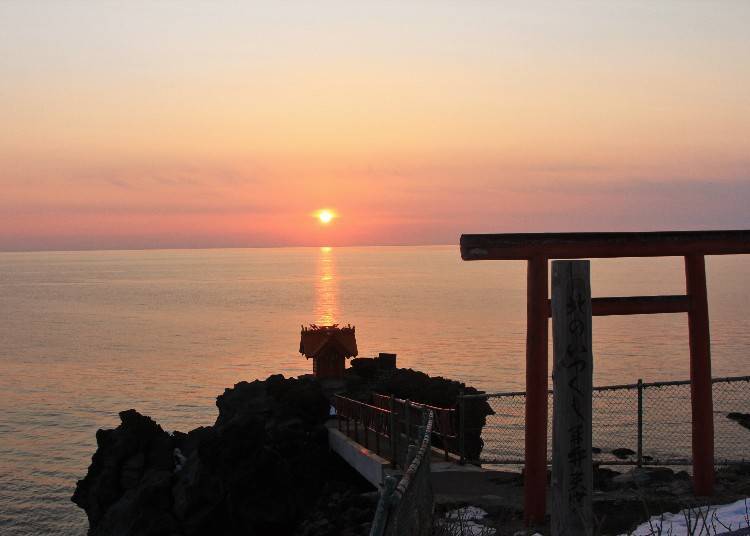
By ferry, Rishiri Island is about 1 hr 40 min from Wakkanai City, the northernmost city of Japan. By plane, it's about 55 min from both Sapporo Okadama Airport and New Chitose Airport, which also operates international flights in the summer.
From both the ferry and airports, Itsukushima Bentengu Shrine is about 20-25 min away by rental car. Although service is somewhat limited, there's also a fixed-route bus that goes around the island.
The island is home to many attractions, including unusual seaside rock formations such as Neguma-no-Iwa (Sleeping Bear Rock) and Jinmen-iwa (Human Face Rock).
Mount Rishiri, also known as Rishiri-Fuji (the Fuji of Rishiri), sits in the island's center at an altitude of 1,721m, surrounded by beautiful scenery.
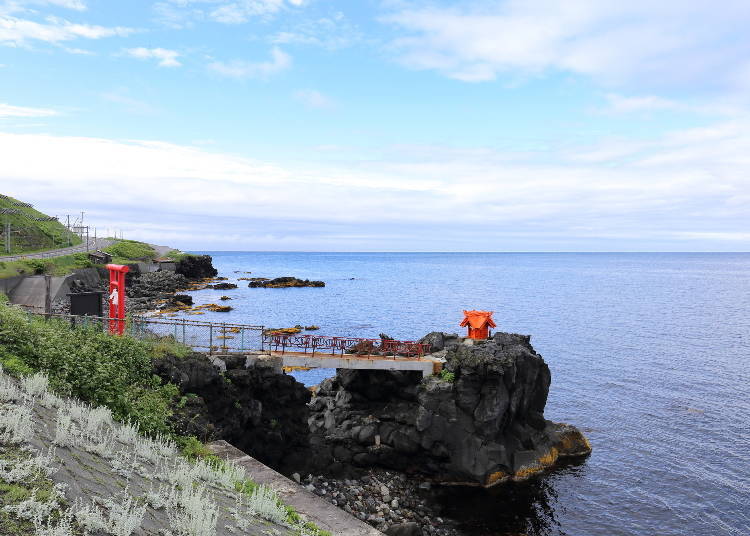
Legend has it that the shrine was built by local sailors long ago as a gratitude offering to the god, Benzaiten, who was believed to have protected their ship from meeting a disastrous fate due to a storm at sea.
The date of the shrine's establishment remains unknown, but it is believed to have been built in the early 1900s. Some town records suggest it was established around 1902. The current shrine was restored in 1967.
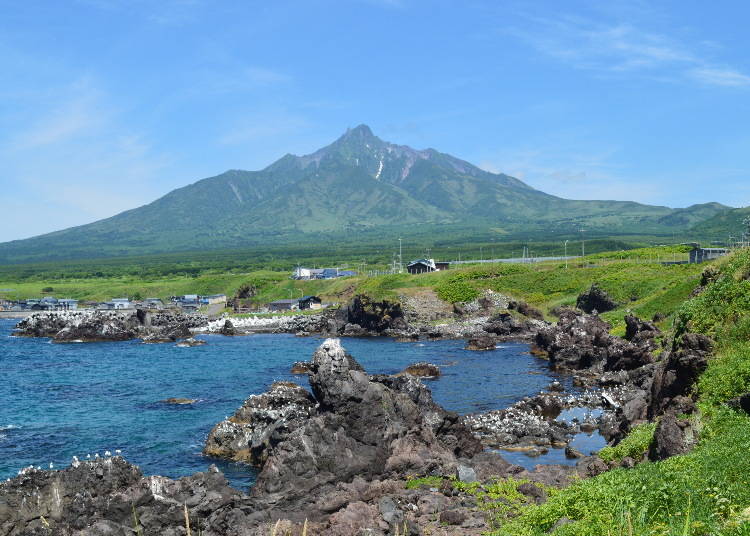
Rishiri Island's tourist season is generally from May to September, peaking in July and August. Popular attractions include the view spots scattered throughout the island and local dishes made with the town's famous sea urchin and kelp.
For those up to the physical challenge, you can even climb Mount Rishiri!
-
Kitano Itsukushima Bentengu北のいつくしま弁天宮
- Address Senboushi, Rishiri, Hokkaido 097-0311
5. The two quirky rocks taking over social Media: Ebisu Rock and Daikoku Rock (Yoichi, Hokkaido)
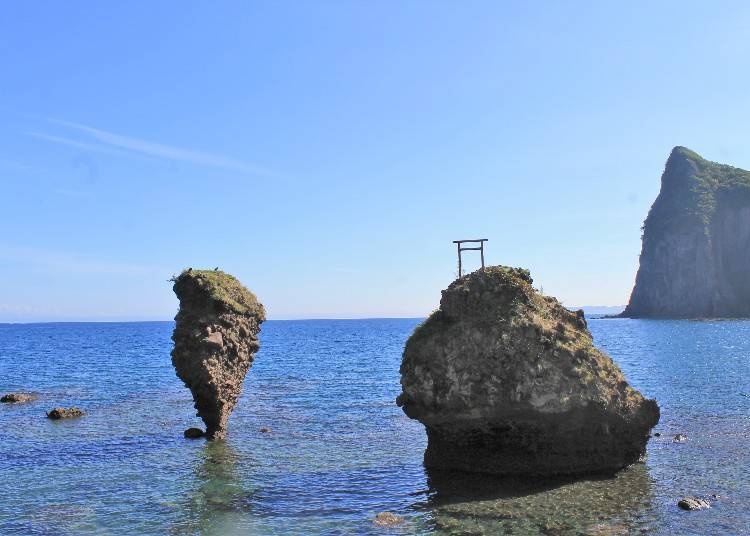
In Yoichi Town, located in midwestern Hokkaido, a torii gate appears to be sitting atop a strange rock protruding from the sea. This is the view spot called Ebisu Rock and Daikoku Rock.
The smaller rock that tapers toward the base is Ebisu Rock, and the more sturdy one is Daikoku Rock. This attraction has become rather famous recently as a scenic spot on social media.
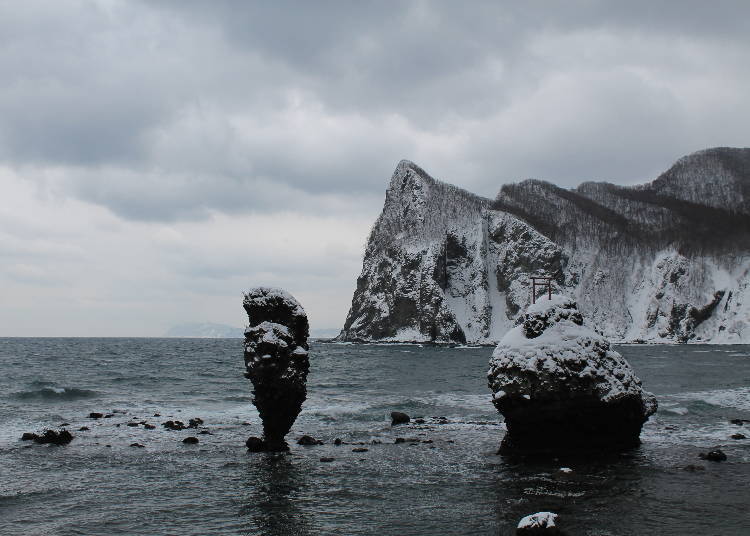
The town of Yoichi lies next to Otaru, another famous tourist destination. In recent years, multiple wineries have popped up around the town, attracting the attention of wine lovers and gourmet enthusiasts alike.
The Ebisu and Daikoku Rock formations can be reached in about 45 minutes by car from Otaru City and about 1 hr 30 minutes from Sapporo City.
Although you can park in front of the old tunnel ruins along the road overlooking the rocks, there is no parking lot. There's also a local bus that departs from Otaru Station (about 1 hr) and Yoichi Station (about 20 min). Ride either bus to Shiroiwacho, and walk for about 5 minutes.
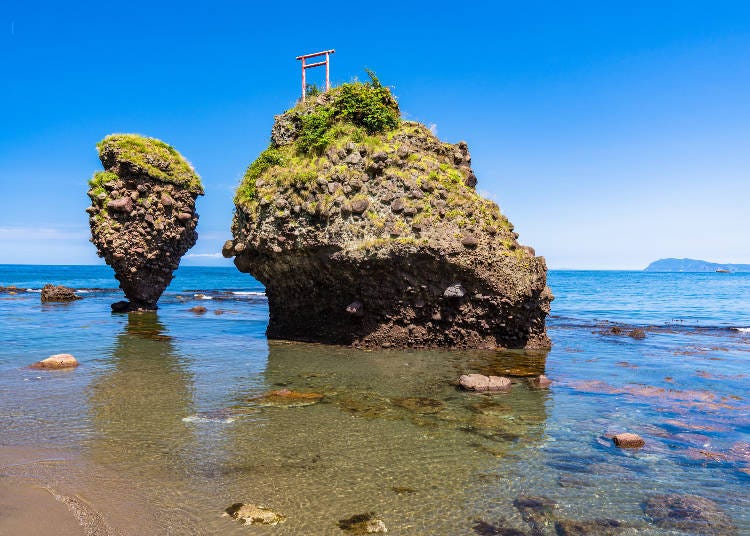
The two rocks lie about 10m offshore. While you can't walk up to the rocks directly, you can take pictures from the coastal road or from the beach.
Since the sea extends to the east, the best time to photograph the rocks is in the afternoon when they are exposed to light.
You may even be lucky enough to capture the beautiful sunrise in the early hours in clear weather!
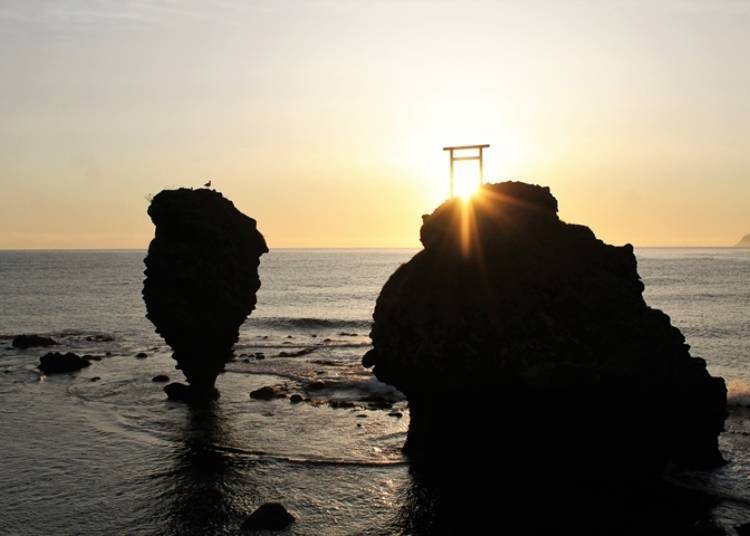
Ebisu Rock is about 10m high with a diameter of 1.2m at the base. Daikoku Rock is about 7m tall, with a torii gate on top of about 1.5m in height and width.
The torii was built in the latter half of the 1980s with permission from the town hall by local volunteers as a prayer for abundant catches and safe travels for ships at sea.
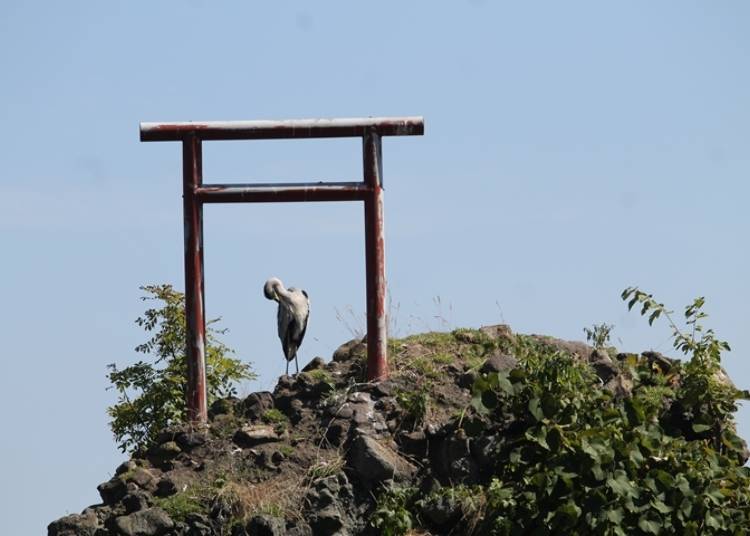
There are several other interesting rock formations in the area, including Rosoku-iwa (Candle Rock) and Setakamui Rock. Due to their proximity to Sapporo City and Otaru City, these are also popular attractions as photo spots and as rest stops during a drive. It's an area with several stunning views that are relatively easy to visit.
-
Ebisu Rock & Daikoku Rockえびす岩と大黒岩
- Address Shiraiwa, Yoichi, Hokkaido 046-0031
Hokkaido is home to a number of torii gates in interesting places, whether atop seaside rocks or in the sea itself! While everything ultimately depends on the weather, there is no doubt that with the right timing, you can capture some incredible, picture-perfect shots.
Whether to take photos, offer prayers, or both, these torii gates are attractions you won't want to overlook!
Text by: Nobuka Kawashima
*Information in article as of March 2022. Please see official websites for the latest updates.
Translated by: Krys Suzuki
A travel creator who has traveled all over Hokkaido in search of spectacular scenery and local gourmet food, Nobuka moved to Hokkaido from Tokyo in 2009. Since then, she has continued to photograph and write articles on Hokkaido travel and food for LIVE JAPAN and other tourism websites and travel magazines. She is a certified Hokkaido Tourism Master, a title given to Hokkaido tourism experts by the Hokkaido Chamber of Commerce and Industry, and also holds certifications as a Domestic Travel Service Supervisor and Chief Itinerary Manager. As a transgender person herself, she runs a support group to create an environment that makes travel easier for LGBTQ people, and also gives lectures and talks at universities and companies.
*Prices and options mentioned are subject to change.
*Unless stated otherwise, all prices include tax.
Popular Tours & Activitiess
Recommended places for you
-

LakeAkan
Rivers, Lakes & Canyons
Abashiri
-
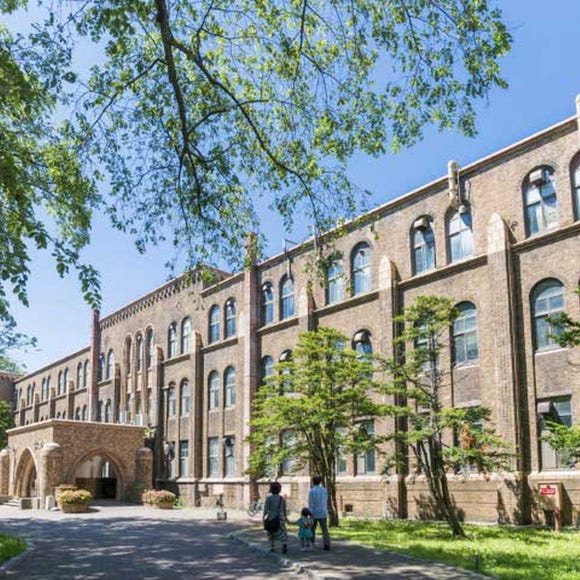
Hokkaido University
Other Architecture
Sapporo / Chitose
-
Appealing

Shiroi Koibito Park
Theme Parks
Sapporo / Chitose
-
Appealing

Sapporo Ramen Yokocho
Ramen
Sapporo / Chitose
-

Niseko Village Ski Resort
Skiing & Snowboarding
Niseko / Rusutsu
-
Appealing

Rukku and Uohei
Izakaya
Sapporo / Chitose
-

Beyond Hakodate and Matsumae: Enjoy the Hidden Gems of Hokkaido’s Donan Area
-

7 Iconic Hokkaido locations that will make your Instagram shine
by: Himanshi Shah
-
Ad

Cycling Through Hokkaido: Discover the Beauty of Memuro and the Tokachi Plains
-
Ad

Smart Ways to Avoid Crowds and Enjoy a Safe, Comfortable Trip to Otaru.
-
Ad

Sapporo SATUDORA Shopping Guide: Get Souvenirs, Medicine & More at This Iconic Drugstore (Special Deal Inside!)
-
Ad

Smart Ways to Avoid Crowds and Enjoy a Safe, Comfortable Trip to Noboribetsu Onsen
-

These 18 Things to Do in Hakodate Will Make You Fall in Love With the Northern Wonderland
by: Guest Contributor
-

Hokkaido Lavender Fields: 6 Best Places in Furano to See Japan's Dreamiest Purple Meadows
by: Nobuka Kawashima
-

Enjoying Hokkaido Shrine in 2025: Traveler's Guide to Rituals, Souvenirs, and Food
-

Tokyo Train Map: Your Essential Guide to Subways and Railways
-

Kichijoji – Explore Tokyo’s Top-Rated Stylish Suburb in Half a Day!
-

Otaru Travel Guide: Inside Hokkaido's Leading Destination (Sightseeing, Food, and Shopping Tips)
- #best sushi hokkaido
- #things to do hokkaido
- #best ramen sapporo
- #what to bring to japan
- #new years in tokyo
- #what to buy in ameyoko
- #japanese nail trends
- #what to do in odaiba
- #onsen tattoo friendly tokyo
- #daiso
- #best sweets otaru
- #japanese fashion culture
- #best nature furano
- #japanese convenience store snacks
- #best japanese soft drinks














